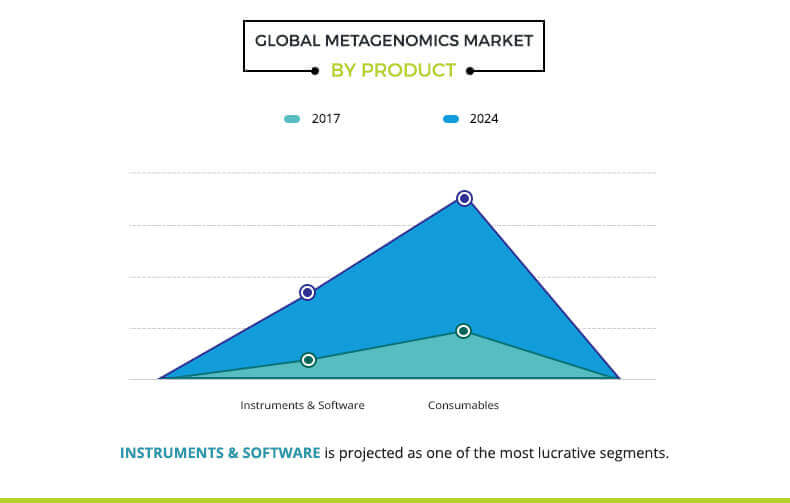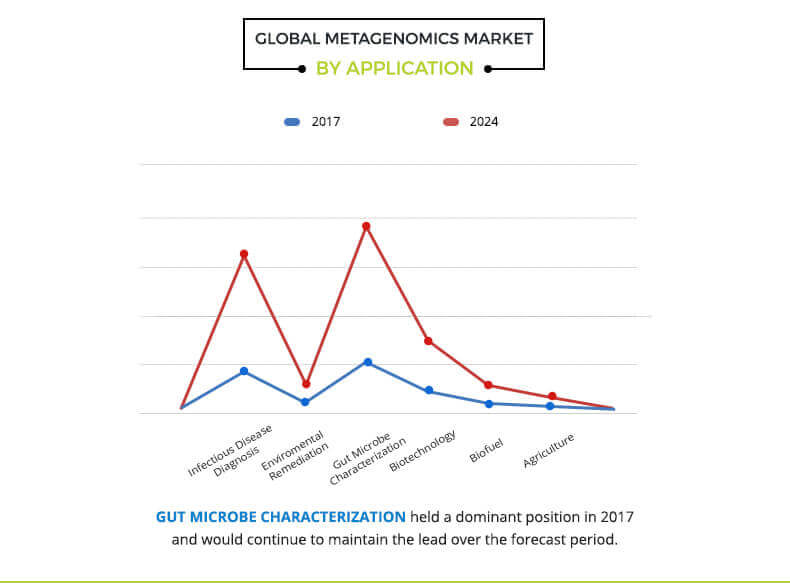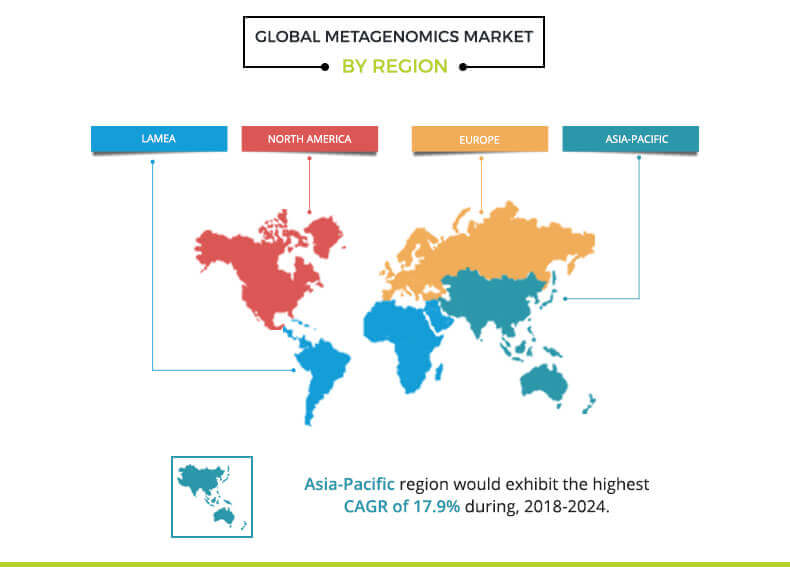Metagenomics Market Overview:
The global metagenomics market was valued at $176 million in 2017 and is expected to reach $523 million by 2024 at a CAGR of 16.8% from 2018 to 2024. Metagenomics comprises studies that use sequencing technologies and bioinformatics tools to obtain useful insights on the diversities in the microbial community and interaction of the microbes in a community. Metagenomic technologies have enabled improved understanding of the microbial ecology and the role of microbiology in the global geochemical cycles through functional metagenomics. In addition, metagenomic studies have allowed researchers to tap into a vast microbial diversity, which was left unaddressed with the conventional microbiology methods.
DNA sequencing platforms have witnessed remarkable progress in the recent years through technological developments. They are highly useful and advantageous as compared to traditional technologies, such as reducing the number of pre-sequencing steps, assuring authenticity of the sequences with long reads (MB to GB) produced per run, and attaining high read accuracy. As DNA sequencing is largely associated with metagenomic studies, advancements in this area are set to propel the growth of the market during the forecast period. Conversely, because metagenomics is a relatively new concept involving analysis of interaction in the microbe community and its interpretation, lack of knowledge regarding this sector is expected to hamper the market growth.
Product Segment Review
Based on product, the global metagenomics market is categorized into instrument & software and consumable. The consumable segment accounted for a major share in the global market in 2017 and is expected to maintain this dominance throughout the forecast period. High adoption of consumables in the pre-sequencing, which is one of the most important steps in the overall metagenomic sequencing protocol, has contributed to the dominant position of this segment in the market. In addition, maximum utilization of consumables ensures that the DNA involved in the metagenomic analysis would be a representative of all cells in the sample and ideal for generation of genomic libraries. Whereas, the instrument & software segment is expected to register the highest growth rate during 2018-2024, owing to the continuous evolution in the development of software packages and instruments utilized in the metagenomic studies.
Application Segment Review
Based on application, the global metagenomics market is segmented into infectious disease diagnosis, environmental remediation, gut microbe characterization, biotechnology, biofuel, and agriculture. The gut microbe characterization segment dominated the global market in 2017 and is expected to maintain this dominance throughout the forecast period. The human intestinal microbiota is a homeostatic ecosystem, which has a significant impact on human health, and the disruption of this equilibrium leads to increased susceptibility to infections by various pathogens. In addition, the application of metagenomics has aided in identifying bacterial pathogens such as Shiga Toxin-producing E. coli (STEC) infection, which is associated with foodborne disease outbreaks. Whereas, the infectious disease diagnosis segment is expected to grow at the fastest pace during the forecast period. This is attributed to the increasing popularity of metagenomic technologies among clinical researchers, which aids in identification of responsible bacterial pathogens in several infectious diseases.
Geography Segment Review
Region-wise, the global metagenomics market is analyzed across North America, Europe, Asia-Pacific, and LAMEA. North America was the major contributor in terms of revenue in 2017 and is anticipated to maintain this dominance throughout the forecast period. This is attributed to the increasing implementation of DNA sequencing across metagenomic applications in this region. In addition, rapid adoption of novel sequencing technologies in this region has contributed to its dominance. Whereas, the Asia-Pacific region is estimated to register the highest CAGR during the forecast period, owing to the considerable patient population base along with the continuously evolving healthcare infrastructure across countries in this region.
The report provides a comprehensive analysis of the key players operating in the global metagenomics market, such as Agilent Technologies, Inc., Enterome SA, F. Hoffmann-La Roche Ltd., Illumina, Inc., Oxford Nanopore Technologies Ltd., Pacific Biosciences of California, Inc., PerkinElmer, Inc., Qiagen N.V., Swift Biosciences, Inc., and Thermo Fisher Scientific, Inc. The other players operating in the global metagenomics market include Siemens AG, ZS Genetics, Inc., Abbott Laboratories, Beckman Coulter, LI-COR, Genomatix GmbH, Beijing Genomics Institute, and Pieriandx.
Key Benefits for Stakeholders
- The study provides an in-depth analysis along with the current trends and future estimations of the global metagenomics market to elucidate the imminent investment pockets.
- A comprehensive analysis of the factors that drive and restrict the market growth is provided.
- The quantitative analysis of the industry from 2017 to 2024 is provided to enable the stakeholders to capitalize on the prevailing market opportunities.
- An extensive analysis of key segments of the industry is provided to understand the products and technologies of metagenomics used globally.
- The key players and their strategies are analyzed to understand the competitive outlook of the market.
Metagenomics Market Report Highlights
| Aspects | Details |
| By Technology |
|
| By Product |
|
| By Application |
|
| By Region |
|
| Key Market Players | Swift Biosciences Inc., Enterome SA, Agilent Technologies, Inc, F. Hoffmann-La Roche Ltd., Illumina, Inc, QIAGEN N.V., Pacific Biosciences of California, Inc., Thermo Fisher Scientific, Inc., PerkinElmer Inc., Oxford Nanopore Technologies Ltd. |
Analyst Review
Metagenomics is still in the nascent stage and has gained significant attention over the years. Metagenomic technologies have the potential to unravel a wider microbial diversity, which otherwise went completely unnoticed and unaddressed by conventional microbial techniques. Introduction of new sequencing technologies and bioinformatics tools has increased the application of metagenomics across comprehension of the microbial community structure, metabolic potential of the microbial community, and identification of novel enzymes.
Factors, such as rising advancements regarding DNA sequencing and surging expansion of metagenomics applications drive the market growth. In addition, increase in the scientific collaboration between metagenomic experiments and computing technologies contributes to the growth of the market. Conversely, dearth of skilled professionals, rise in the concerns regarding standardization, and accuracy of sequencing based diagnostic testing pose a restraint to the market. Whereas, increased focus of key players on investing in untapped economies is expected to open up new avenues for the expansion of the metagenomics market.
Loading Table Of Content...






